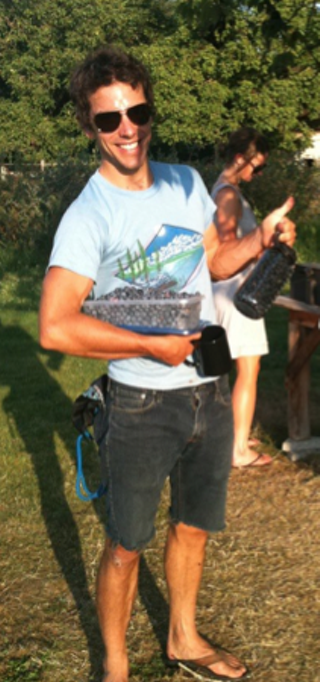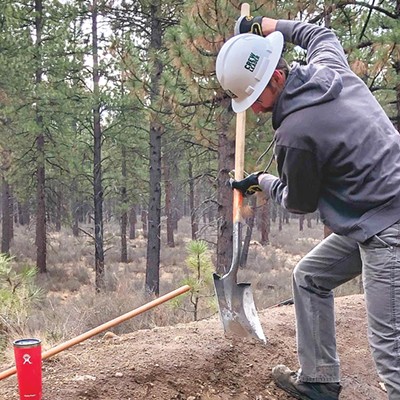Now and again over the past few years, sharp little carpet tacks have shown up in the bike lanes of North Portland, popping bike commuter tires. They signal the ire of residents furious about the city's plan to prioritize biking as part of a larger gentrification effort in the previously working-class neighborhood.
It's the story of a city not including the neighbors, and it's a cautionary tale for Bend, which, like Portland and other North American cities, is aiming to get people out of cars and onto bikes by investing in better bike lane infrastructure. In particular, Bend is embarking on a $1 million project to connect bike lanes from Bend's eastside to westside. The Oregon Department of Transportation has committed $650,000 to the project in downtown Bend and along Drake Park, but those funds will be surrendered if it isn't completed by the end of this fall.
While most of the feedback has been positive, including from bike advocacy groups, and the Bend Park & Recreation District, some neighbors near Drake Park are leery the project will create a host of problems for them. They fear that the removal of some stop signs means faster speeds and traffic jams that will force cars onto quiet neighborhood streets. Mostly, though, some neighbors feel they weren't proactively invited to the discussion by city officials.
"I know that the neighbors in the Drake Park Historical District don't feel like they have been at the table, and they feel like they are going to be directly affected," said City Councilor Doug Knight earlier this week.
Knight, who is a resident of that very neighborhood, said he is particularly worried about what will happen to traffic in downtown.
"My constituents are concerned about the backup that's going to occur at the intersection of Franklin," said Knight, an intersection he said is "already in failure mode."
Particularly on summer days or during farmers' markets, traffic routinely snarls where Riverside Boulevard becomes Franklin Avenue at Wall Street.
Knight fears that by removing stop signs at the beginning of Riverside Boulevard at Tumalo Avenue that the metering of traffic along the park won't happen anymore. That will lead to long lines at the intersection of Franklin and Wall, says Knight. And that, he adds, may push traffic into the neighborhood streets near Louisiana Avenue and Congress Street.
Traffic Engineer Robin Lewis with the city of Bend said her department has examined what will happen at that intersection and she doesn't believe there will be a problem with traffic queuing or a forcing of traffic into the neighborhood.
"We absolutely do not anticipate diversion," said Lewis, adding that metering actually makes traffic lights work poorly. "The traffic signal should actually work more efficiently rather than less efficiently."
Still, Knight said it seems as though all the ramifications of the project have not been considered. Why not have a roundabout, instead of just removing stop signs? It reminds him of the city's controversial water project, he said.
"We are suffering from a similar sense of myopia, a similar psychology where the timing of the funding is being used to shoehorn the project through," he said. "I would hope that we would properly study all of the alternatives before getting to a point where we are forced to implement something that may not be the best solution."
Jan Gifford, chair of the Old Bend Neighborhood Association, which is near the park, also is concerned about the implications of the removal of the stop signs. She said neighbors are worried the changes will allow cars to quickly navigate the corner at Riverside Boulevard and Tumalo Avenue without stopping, making it difficult for pedestrians to cross safely into the park and creating faster speeds.
"There is still a number of neighbors who are really upset," said Gifford. "They love the bike project, but are very concerned about removing the stop signs."
Gifford said residents didn't learn of the project until just a few months ago. Since then city officials have bent over backwards to meet with them, she said, and have assured residents that if the intersection doesn't work, stop signs will be returned.
The city's project manager, Heidi Lansdowne, said the city didn't expect to see any problems with backups and was not considering retiming any lights in downtown to help keep traffic flowing at Wall Street and Franklin.
The Riverside Boulevard Project:
• Two stop signs will be removed at Riverside Boulevard and Tumalo Avenue, creating a tight 22-mph curve that will allow car and bike traffic to flow seamlessly from Galveston Avenue onto Riverside Boulevard and past the park.
• The intersection will then look identical to the one at Riverside Boulevard and Louisiana Avenue and Congress Street, but with brightly colored bike lanes.
• A biking corridor will be created with some buffered bike lanes from Tumalo Avenue up Riverside Boulevard/Franklin Avenue to Lava Avenue. This will help create a bike lane corridor from west to east Bend.
• New bumped-out curbs will be built near crosswalks to make pedestrian crossings into Drake Park safer and to give a feel that drivers are passing through the park rather than alongside it.
How Other Cities Do It
A guide to improving bike commuting in Bend
by James Williams
In 2012, the magazine Bicycling placed Portland at the top of its "America's Top 50 Bike-Friendly Cities." No wonder: With more than 300 miles of bike lanes and a plan tripling that number, the city has solid commitment from its city council. But there is one thread that weaves throughout the other 49 of America's most bike-friendly towns: connectivity, or tying together opposite ends of town with uninterrupted safe-cycling corridors—which is exactly what Bend's advocacy groups are pushing for.
Here's a look at Bicycling's top five, as well as insight into what sets these bike-happy cities apart from the rest:
Portland: Quick to adopt cycling-friendly innovations, Portland has long benefited from citizen support and groups like the Bicycle Transportation Alliance, a nonprofit that pushes for greater safety. Portland State University even has an "Institute for Bicycle and Pedestrian Innovation."
Minneapolis: The gem of Minneapolis, the Cedar Lake Regional Trail, is a 4.5-mile two-way, 10-foot-wide paved path connecting downtown to popular recreation areas. The city also constructed continuous "bike boulevards" and bike lanes that run through downtown.
Boulder: Thanks to miles of uninterrupted bike lanes, the Colorado outdoor-rec haven has established itself as a model city for alternative transportation. Over the last eight years the city has been awarded over $1 million in Safe Routes to School funding.
Washington, D.C.: Bicycling reports that bike commuting in our nation's capital jumped 80 percent from 2007 to 2010, likely due to new, stand-alone bike lanes. D.C. also started the country's first automated bike-share system, and is dedicated to getting minorities on bikes.
Chicago: Chicago also subscribes to the idea of protected bike lanes, which studies say increase ridership. Chicago already has more than 170 miles of protected and buffered bike lanes, but former Obama White House chief of staff and theWindy City's current mayor, Rahm Emanuel, has signed off on a plan calling for another 100.























